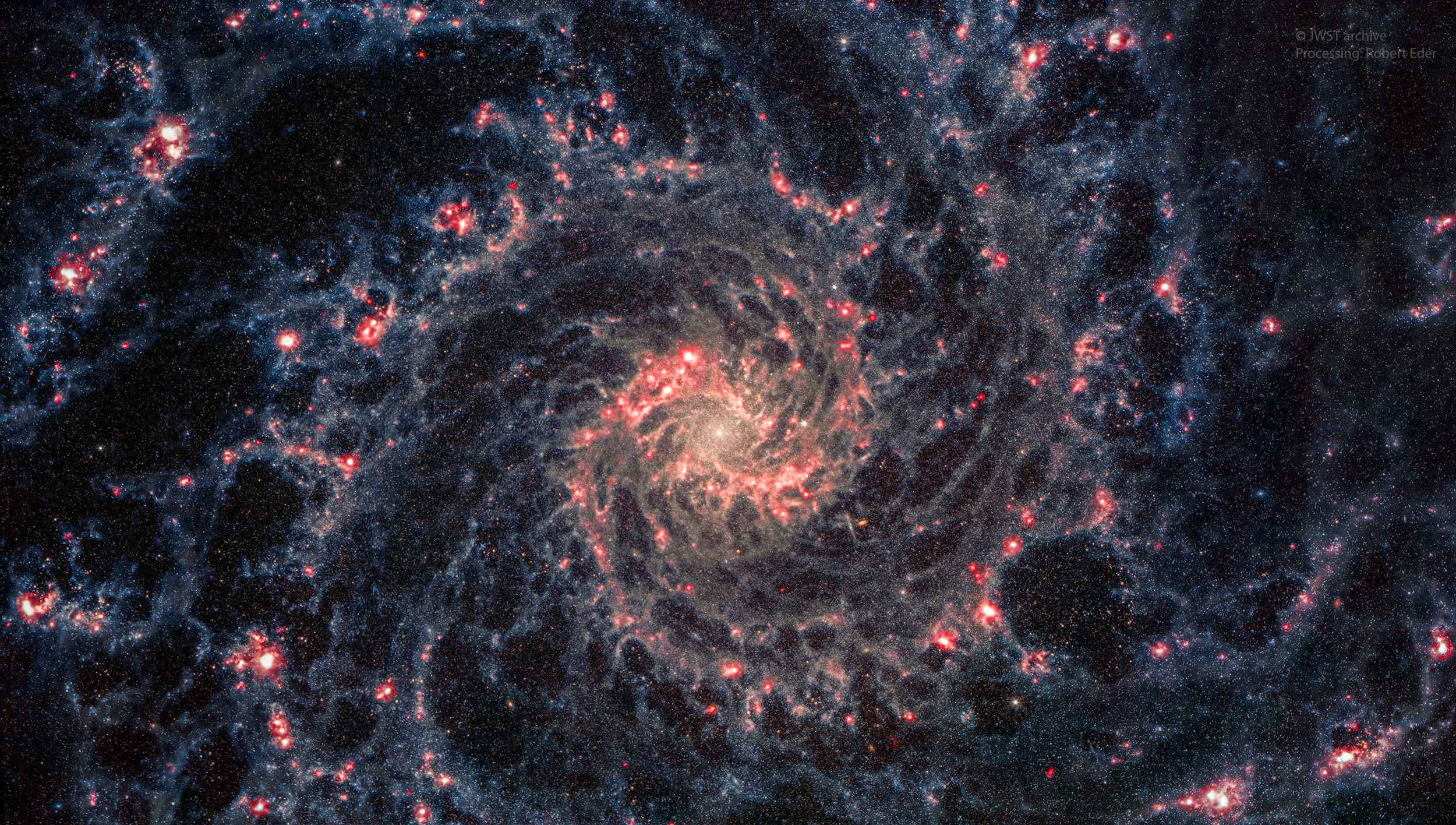
Posted on 07/22/2022 4:07:49 PM PDT by MtnClimber
Explanation: Beautiful spiral galaxy Messier 74 (also known as NGC 628) lies some 32 million light-years away toward the constellation Pisces. An island universe of about 100 billion stars with two prominent spiral arms, M74 has long been admired by astronomers as a perfect example of a grand-design spiral galaxy. M74's central region is brought into a stunning, sharp focus in this recently processed image using publicly available data from the James Webb Space Telescope. The colorized combination of image data sets is from two of Webb's instruments NIRcam and MIRI, operating at near- and mid-infrared wavelengths. It reveals cooler stars and dusty structures in the grand-design spiral galaxy only hinted at in previous space-based views.
For more detail go to the link and click on the image for a high definition image. You can then move the magnifying glass cursor then click to zoom in and click again to zoom out. When zoomed in you can scan by moving the side bars on the bottom and right side of the image.

Just imagine...
that is what it looked like 32 million years ago...
If/when we gain more knowledge, perhaps we can determine
what these far away objects look like now...
We’ll know what they look like now in 32 million years 🤪
Galaxies hardly change in 32 million years. I think it takes about a hundred million years for one of them to go around once.
The only way for Earth people to gain that knowledge is to wait 32 million years for the image to arrive here.
Then, if there are any left, the Earth people of 32002022 will be able to see what that galaxy looked like in 2022, assuming it is still there, and assuming they are still interested.
dont worry, you may get lucky and see it photoshopped into a local area’s nightscape and get impressed by the “Explanation” how “...the local photography took 157 pictures...” etc etc etc...
thats the way you’ll see it real time!!
Cool unimaginably hot stuff.
32 million light years away and contains 100 Billion stars.
.
Is That Correct?
And we call
Messers M74,
That is Not doing
It Justice.
Yes, I think that is correct. At least it was about 32 million years ago.
Give or take.
100 billion is a very round number. They certainly did not count them all.
I wonder...looking at the picture, do galaxies generally turn clockwise? Or counterclockwise? (Some look like disturbed wasp nest!)
A sort of slide.....Here is a link to article on Water and Coriolis force at:
https://www.livescience.com/33567-toilet-swirl-direction-equator.html
Snip....."Shapiro began his experiment by filling a large, shallow dish with water, making sure that the water entered the dish with a clockwise swirl, the opposite direction you'd expect it to turn in the Northern Hemisphere. He covered the dish with a plastic sheet, which removed any air drag, and let the water stand for 24 hours to negate its initial spin. When Shapiro first unplugged a drain at the bottom of the dish, he didn't notice any rotation to the water as it drained. However, after some time the water eventually began to swirl counterclockwise, though at a slow rate.
A few years later, another research team at the University of Sydney showed the opposite to be true in the Southern Hemisphere."
Anything like that on a galactic scale?
Let's do a thought experiment.
Imagine that you are looking at a galaxy 1 million light years away from earth and that it appears to be rotating clockwise.
Now imagine that there is an observer on a habitable planet in the same direction as that galaxy and 2 million light years away from earth.
From that distant observers vantage point, in which direction will the galaxy be rotating?
I see a Klingon Bird of Prey decloaking, almost inverted, in the lower right corner.
On earth, water rotates in the same direction in the northern and in the southern hemisphere. It's just that on the opposite hemisphere, you're looking at it from the other side. It does that, though, because gravity and the spherical surface of the earth constrain the water to move on the surface, subjecting it to the Coriolis force. As it moves toward the equator, it must move faster in order to stay on the sphere. It is this sideways acceleration that causes it to spin.
In the universe, there is no spherical surface and even no known center. Therefore, I would expect no uniform spin. I would expect no consistent spin direction of galaxies. It would still look like it's spinning the opposite direction when you look at it from the other side, but you would see galaxies spinning in both directions regardless of where you looked from. On earth, water spins consistently everywhere you look at it in one hemisphere.
Disclaimer: Opinions posted on Free Republic are those of the individual posters and do not necessarily represent the opinion of Free Republic or its management. All materials posted herein are protected by copyright law and the exemption for fair use of copyrighted works.